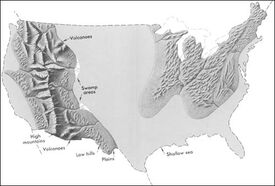
Geography of the US in the Late Cretaceous Period
Late Cretaceous refers to the second half of the Cretaceous Period, named after the famous white chalk cliffs of southern England, which date from this time. Rocks deposited during the Late Cretaceous Period are referred to as the Upper Cretaceous Series.
This was a period of great success for dinosaurs, with many new types appearing and diversifying, such as the Tyrannosaurs, duck bills, Ankylosauridae, and horned dinosaurs in Asiamerica (Western North America and eastern Asia), and Titanosaurs and Abelisaurs in Gondwana.
Birds became increasingly common and diverse, replacing the pterosaurs which retreated to increasingly specialised ecological niches.
In the seas, mosasaurs suddenly appeared and underwent a spectacular evolutionary radiation. Modern sharks also appeared and giant-penguin-like polycotylid pliosaurs (3 meters long) and huge long-necked elasmosaurs (13 meters long) also diversified. These predators fed on the numerous teleost fishes, which in turn evolved into new advanced and modern forms (Neoteleostei).
Near the end of the Cretaceous Period, flowering plants diversified and didelphid marsupials and primitive placental mammals also became common.
| Cretaceous period | |
|---|---|
| Lower/Early Cretaceous | Upper/Late Cretaceous |
| Berriasian | Valanginian | Hauterivian Barremian | Aptian | Albian |
Cenomanian | Turonian | Coniacian Santonian | Campanian | Maastrichtian |